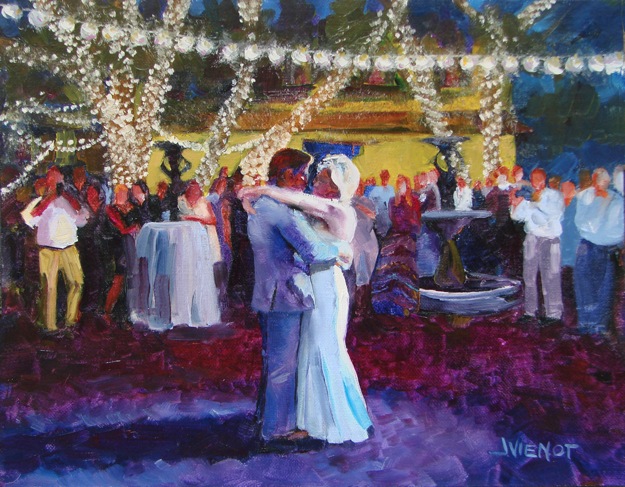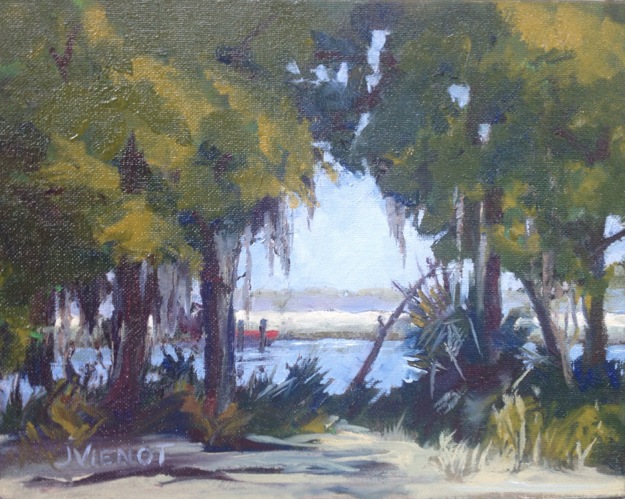 When I take an art workshop, it provides a wonderful break from the full-time management of my pool service business and an opportunity to fully immerse myself in my art. I counted this week as a 6-day vacation, first participating in the two-day Destin Festival of the Arts (Mattie Kelly Arts Foundation) on Saturday and Sunday, then attending a Bill Farnsworth workshop through the Apalachicola School of Art Monday, Tuesday, and Wednesday, and finally, painting with Mary Erickson on Thursday.
When I take an art workshop, it provides a wonderful break from the full-time management of my pool service business and an opportunity to fully immerse myself in my art. I counted this week as a 6-day vacation, first participating in the two-day Destin Festival of the Arts (Mattie Kelly Arts Foundation) on Saturday and Sunday, then attending a Bill Farnsworth workshop through the Apalachicola School of Art Monday, Tuesday, and Wednesday, and finally, painting with Mary Erickson on Thursday.
 The Emerald Coast Plein Air Painters had a booth in the Destin Festival of the Arts, with 6 painters representing the group. I enjoyed interacting with the festival-goers, talking to the other artists in our booth, and plein air painting one morning. A lot of work goes into a festival booth. Marian Pacsuta and her husband erected the tent, so it was fully assembled with ProPanels and wind-weights already in place by the time the rest of us arrived to hang our art on the curtain hooks Marian provided. She had a small table set up, covered to the ground with black spandex cloth. I had made some flyers explaining our group, and some group business cards the day before, so those were on the table along with artists’ business cards and a clipboard for folks to sign who wanted to receive the weekly notifications of our painting locations. To make sure the booth was manned at all times, I had scheduled the 6 participating artists and two additional artists helping, in two- and three-person shifts throughout the festival. At the end of the second day, we all converged to pick up our art and take down the tent, a feat accomplished in a mere 20 minutes. Many of us painted en plein air during the festival. I arrived early on the second day and had an uninterrupted block of time to paint my scene en plein air before festival goers came, and then I was able to add in a few people.
The Emerald Coast Plein Air Painters had a booth in the Destin Festival of the Arts, with 6 painters representing the group. I enjoyed interacting with the festival-goers, talking to the other artists in our booth, and plein air painting one morning. A lot of work goes into a festival booth. Marian Pacsuta and her husband erected the tent, so it was fully assembled with ProPanels and wind-weights already in place by the time the rest of us arrived to hang our art on the curtain hooks Marian provided. She had a small table set up, covered to the ground with black spandex cloth. I had made some flyers explaining our group, and some group business cards the day before, so those were on the table along with artists’ business cards and a clipboard for folks to sign who wanted to receive the weekly notifications of our painting locations. To make sure the booth was manned at all times, I had scheduled the 6 participating artists and two additional artists helping, in two- and three-person shifts throughout the festival. At the end of the second day, we all converged to pick up our art and take down the tent, a feat accomplished in a mere 20 minutes. Many of us painted en plein air during the festival. I arrived early on the second day and had an uninterrupted block of time to paint my scene en plein air before festival goers came, and then I was able to add in a few people.
 At 5:00 the next morning I jumped in the car to drive the two-hour trip to Apalachicola for the Bill Farnsworth workshop. Bill is one of the featured “plein air ambassadors” of the Forgotten Coast En Plein Air event in Apalachicola. I had seen and admired his work, so when the Apalachicola School of Art advertised his workshop, it was an easy decision to sign up. The workshop was billed as Field to Studio, but the 20 mph winds and rains of the remnants of Mexico’s Hurricane Patricia were emptying out on the Gulf Coast, so we just painted in the studio using photo references that Bill had brought. His demos seemed to build from silhouetted shapes to high contrast to color, first completing much of the detail of his focal area before progressing to the less emphasized parts of the composition. The first day I painted the trailered oyster boat on the left, from a photo that Bill brought, and the second day I painted his photo of a blue truck at a seafood business.
At 5:00 the next morning I jumped in the car to drive the two-hour trip to Apalachicola for the Bill Farnsworth workshop. Bill is one of the featured “plein air ambassadors” of the Forgotten Coast En Plein Air event in Apalachicola. I had seen and admired his work, so when the Apalachicola School of Art advertised his workshop, it was an easy decision to sign up. The workshop was billed as Field to Studio, but the 20 mph winds and rains of the remnants of Mexico’s Hurricane Patricia were emptying out on the Gulf Coast, so we just painted in the studio using photo references that Bill had brought. His demos seemed to build from silhouetted shapes to high contrast to color, first completing much of the detail of his focal area before progressing to the less emphasized parts of the composition. The first day I painted the trailered oyster boat on the left, from a photo that Bill brought, and the second day I painted his photo of a blue truck at a seafood business.
 At the risk of losing my momentum here, a little rant about artistic ethics: It’s not right to pass off a painting of someone else’s image as your own. Photography is an art in itself. If someone else shot the photo, they made the compositional decisions, and probably did some post-processing. I encourage everyone to always make sure you disclose that you used someone else’s photo reference, and give him or her credit. I know there are an abundance of images available on the internet, and some artists, even recognized artists and instructors, merely download an image from the internet and then paint it. Some artists even copy other artist’s paintings, and call them their own! I’ve coordinated exhibits where artists signed a statement of ownership when their work is clearly a copy of someone else’s work! Explaining rejections of art due to ethics is difficult when people do not have the same values. Don’t get me wrong, there is a world of benefit in copying someone’s painting, especially a Master. I never learned so much as in one semester in college when I made it my assignment to copy drawings by recognized Masters, from daVinci and Michelangelo to Degas. But it’s wrong to call it your own art, without crediting the artist or photographer. I’ve even had friends download my photos from Facebook and then re-upload them without giving me credit, instead of using the convenient “share” button that Facebook provides. OK, enough about that. So I do sell my workshop paintings that used someone else’s photo, to recover the cost of the workshop, but I always disclose it and would not enter them in an exhibit or competition.
At the risk of losing my momentum here, a little rant about artistic ethics: It’s not right to pass off a painting of someone else’s image as your own. Photography is an art in itself. If someone else shot the photo, they made the compositional decisions, and probably did some post-processing. I encourage everyone to always make sure you disclose that you used someone else’s photo reference, and give him or her credit. I know there are an abundance of images available on the internet, and some artists, even recognized artists and instructors, merely download an image from the internet and then paint it. Some artists even copy other artist’s paintings, and call them their own! I’ve coordinated exhibits where artists signed a statement of ownership when their work is clearly a copy of someone else’s work! Explaining rejections of art due to ethics is difficult when people do not have the same values. Don’t get me wrong, there is a world of benefit in copying someone’s painting, especially a Master. I never learned so much as in one semester in college when I made it my assignment to copy drawings by recognized Masters, from daVinci and Michelangelo to Degas. But it’s wrong to call it your own art, without crediting the artist or photographer. I’ve even had friends download my photos from Facebook and then re-upload them without giving me credit, instead of using the convenient “share” button that Facebook provides. OK, enough about that. So I do sell my workshop paintings that used someone else’s photo, to recover the cost of the workshop, but I always disclose it and would not enter them in an exhibit or competition.
Finally, on the last day of Bill’s workshop, the sun came out and the winds died down and the birds sang! We had opportunity to paint en plein air in the morning and again in the afternoon after Bill’s demo. I tried hard to remember Bill’s focus on relative temperatures of color, as well as relative values. I painted an old but still living tree, and I painted the St. George Island lighthouse and museum.
The day after Bill’s workshop, I took a bonus day away from work, since my staff had handled everything well in my absence, my only concern being when my office manager used the words “creative accounting” to explain how she resolved a cash-flow situation, oh dear.
I used my extra day to paint with Mary Erickson, the Forgotten Coast en Plein Air’s Artist in Residence at St. Joe Buffer Preserve. With my sweet host and fellow classmate and painter extraordinaire Lynn Wilson (On the Waterfront Gallery) and other friends and fellow classmates, I had attended Mary’s introduction a couple nights before, where she had shown her amazing paintings in support of the buffer preserve’s mission of appreciation and conservation of the wildlife and exquisite dune and marsh habitats.
We found Mary at sunrise Thursday morning, and watched her deftly capture the pink and orange light on the clouds and the dunes. I decided to paint on some 4×6 miniature linen panels that I had bought by mistake, intending to buy a different size, and only 5, not 50! I painted 3 studies of the wildflowers in the changing light over the course of the day.
All in all, a fabulous week, and delivering 5 newer paintings to be shown at On The Waterfront Gallery in Apalachicola, to boot!



















































